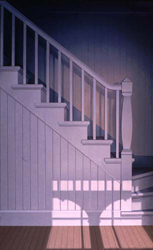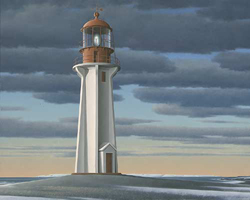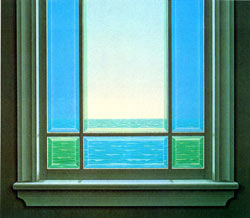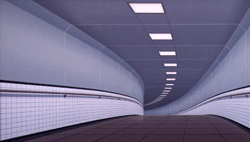

|
Age 12-14 Pick a memory  There are times when Christopher Pratt relies on his memories for images to paint or draw.
There are times when Christopher Pratt relies on his memories for images to paint or draw. Do you use your memories as a source of ideas for writing, composing music or making art too? What other ways do you use your memory? Look at Distant Fire: Stairway at Cape Anguille, painted by Christopher in 2000. Does it remind you of a place you have been? Can you imagine how it would feel if you stood in your bare feet on the sun warmed floorboards? What kind of sounds can you hear in this painting? Is it a loud or quiet image? Try this exercise: imagine a special house you have once visited or lived in. What do you remember most about the house? You may remember the staircase whose steps may have creaked even when no one was there walking on them. Maybe it would be the long bathtub that allowed you to stretch out completely. Try following Christopher's example. Draw a rough, simple sketch of your remembered place. With time and more drawing practice, your initial sketches will become more refined and detailed. Then you can turn it in to a painting. Christopher decides to paint a drawing when he feels he has captured the essence of the distant memory. Why do you think he tests his memory by drawing specific details of a place he has once lived or visited? Would it be simpler for him to return to the actual place and take a photograph of it instead of relying on a memory to define it accurately?
Sometimes the memory of a place is more important than the place itself. Concentrating on a remembered place affords you the time to explore the memory further. This creative process can trigger more details of the place such as conversations you may have had, smells and sounds you associate with the initial memory. There is a special feeling called nostalgia. This feeling occurs when you're reminded of a specific place from long ago. You may experience nostalgia from seeing a specific colour or from smelling a particular fragrance. Perhaps the place you recall no longer exists and it may make you feel sad to remember it. The feeling of nostalgia is very similar to the feeling of déjà vu; it is something you recall from long ago and you try ever so hard to hold on to it before it dissipates. Alas, the feeling passes and you feel rather odd but happy to have revisited the sensation. Most of the stairways, wallpaper patterns, windows, and exteriors of houses appearing in Christopher's artwork are images he recalls from memory. The titles of his work suggest actual places but if you were to visit these real places, you would probably discover that his paintings do not truly represent the actual place.  If you brought this painting with you to Ferolle Point, you would notice immediately that there are
details missing from Christopher's painting of the lighthouse and surrounding land. This omission
of detail is intentional. Christopher is interested in capturing or sustaining the fleeting moment
of the memory instead of copying what already exists.
If you brought this painting with you to Ferolle Point, you would notice immediately that there are
details missing from Christopher's painting of the lighthouse and surrounding land. This omission
of detail is intentional. Christopher is interested in capturing or sustaining the fleeting moment
of the memory instead of copying what already exists.
Find another image from the Gallery that reminds you of a personal memory. Explore your memory by writing or drawing rough sketches of the place, person or thing you remember. Refine the image by redrawing it, stressing the importance of descriptive language, texture, colour, object details and other intimate features. It would be thoughtful of you to give the image to someone who would appreciate the memory for similar reasons you do.  Memorial
Window (1982) can be read or understood as a metaphor for
Confederation history of Newfoundland and Labrador (NL). The window itself
is not a specific window but may serve as a symbol of loss and sacrifice. Memorial
Window (1982) can be read or understood as a metaphor for
Confederation history of Newfoundland and Labrador (NL). The window itself
is not a specific window but may serve as a symbol of loss and sacrifice.
During the 1960's Newfoundland's first Premier, Joseph R. Smallwood, initiated several politically "progressive" movements that was hoped would improve NL's economical and social position within the country of Canada. Resettlement was a chosen method the government used to entice people to move from isolated communities into larger centers where they could readily receive benefits such as larger schools and better-equipped and staffed hospitals. A larger center would cost the government less money to support a large population of people rather than a mass of people living all over a huge land mass (NL is larger than the total mass of its three neighboring provinces: Prince Edward Island, Nova Scotia and New Brunswick). Many Newfoundlanders did not want to leave their homes but had to because of a majority rule. Some people even towed their houses by boats over the ocean to the new communities. Memorial Window is a window at sea, a symbol to stand for the various sacrifices Newfoundlanders have made for their province and country.  The
precision with which Christopher renders his art work is reminiscent to
that of that of an architect. It is obvious from looking at Pedestrian
Tunnel (1991) that he has an avid interest in formal geometry.
As you have read above, his images begin as rough sketches, which he refines
by his intuitive sense for certain proportions. Proportion refers to how
smaller parts make up the whole. After deciding which drawn image he is
going to use for a painting, he will apply a geometric diagram (a grid)
to line up defining points of perspective that conform to the lines he has
chosen intuitively. The
precision with which Christopher renders his art work is reminiscent to
that of that of an architect. It is obvious from looking at Pedestrian
Tunnel (1991) that he has an avid interest in formal geometry.
As you have read above, his images begin as rough sketches, which he refines
by his intuitive sense for certain proportions. Proportion refers to how
smaller parts make up the whole. After deciding which drawn image he is
going to use for a painting, he will apply a geometric diagram (a grid)
to line up defining points of perspective that conform to the lines he has
chosen intuitively. Do you have an instinct for proportions? Consider a chair. You are familiar with the standard height of a chair because of your intuitive sense based partially on your height. If you were to draw a chair, you would not have to measure one with a measuring tape. You would intuitively know its height and dimensions, knowing already how your knees bend and how your back is supported from your previous chair sitting experiences.
|
